Different parts of our hands have their own names in English. Let’s learn the name of our hand parts. You’ll be able to say the name of each finger in English as well. Learning body parts vocabulary will help you with daily conversations as well as medical situations. You might need to see a doctor and explain which part of your hand hurts. Now, let’s check out the list of the hand parts.
Parts of the Hand Names
Let’s learn how we call each part of our hands in English with pictures.

Back of the Hand
Example sentence: As she walked through the dark room, she felt the cool surface of the table against the back of her hand.

Cuticle
Example sentence: The manicurist gently pushed back the cuticle to reveal a neat and tidy nail bed.

Fingernail
Example sentence: He painted his fingernails a vibrant shade of red for Christmas.

Fingers
Example sentence: She traced the outline of the flower with her fingers, feeling the delicate petals beneath her touch.

Fist
Example sentence: With determination, he clenched his fist and knocked on the door, signalling his intent to enter.
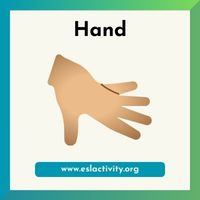
Hand
Example sentence: She reached out her hand to catch the falling leaf, feeling its crisp texture.

Index finger
Example sentence: Using her index finger, she pointed to the location on the map where they were planning to meet.

Knuckles
Example sentence: After finishing the intense workout, he felt a satisfying pop in his knuckles as he stretched his fingers.
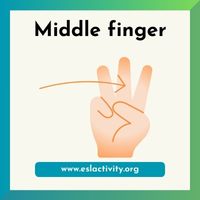
Middle finger
Example sentence: As she applied the ointment, she massaged it gently into her skin using her middle finger, soothing the sore area.

Palm
She held the warm cup of tea in the palm of her hand, feeling the comforting heat seeping through her fingers.
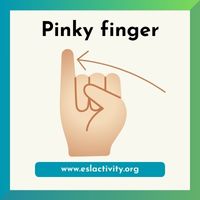
Pinky Finger
Amy extended her pinky finger gracefully, adding a touch of elegance to her afternoon tea.
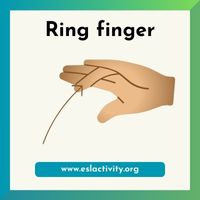
Ring Finger
She slid the shiny engagement ring onto her ring finger, symbolizing the commitment they had made to each other.

Thumb
He pressed the button with his thumb to turn on the flashlight for guidance in the dark tunnel.
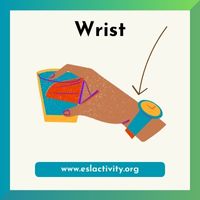
Wrist
She wore a beautiful bracelet around her wrist that she got for her birthday.
Parts of the Hand in English
Use the following picture to learn hand vocabulary. Simply go over the list of the hand parts on your way to school, home, or work. You can do that on the subway or bus. It’s super handy. Review it a few times, and you’ll find yourself already memorized the name of the fingers and different parts of the hand.
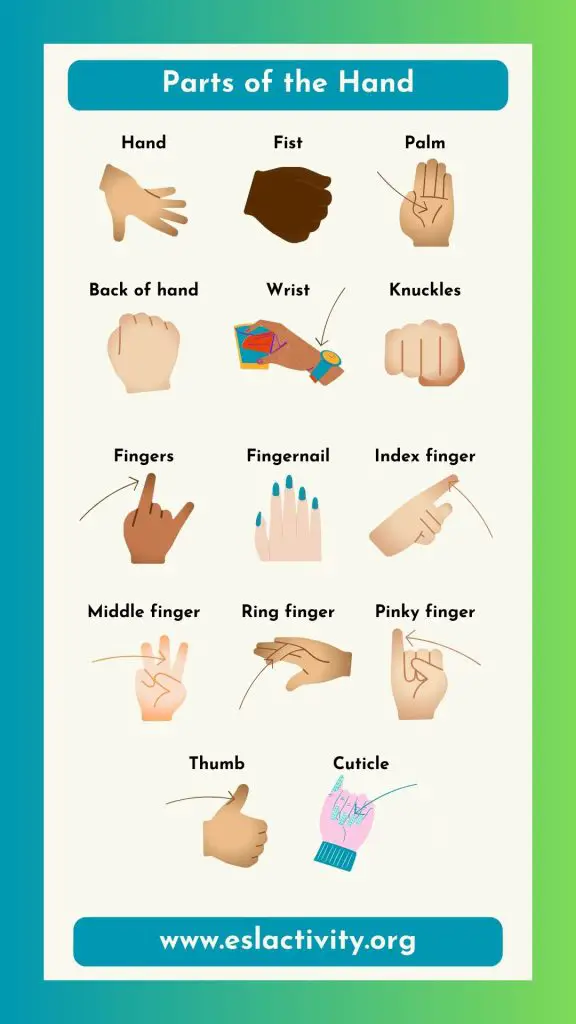
Hand Parts Name FAQs
Here are some of the most frequently asked questions about hand parts and finger names.
What are the names of the fingers?
The names of the fingers are thumb, index finger (or pointer finger), middle finger, ring finger, and pinky finger.
Why is the thumb not called a finger?
The thumb is called a thumb and not a finger because the structure is different. The thumb has only two parts, while the other fingers have three. The special ability of a thumb to move and touch other fingers is called being “opposable.” So, it’s named the thumb to highlight its unique role in how our hands work.
What are the different parts of my hand?
Your hand has several distinct parts. Firstly, there are five fingers: the thumb, index finger, middle finger, ring finger, and pinky finger. The broad and fleshy area beneath these fingers is called the palm. Additionally, the wrist connects your hand to the forearm, forming the joint that allows for movement and flexibility.
What are the parts of the palm?
Our hand’s palm has a few different parts. At the base of your thumb, there’s a fleshy area called the thenar eminence, while the pinky side has the hypothenar eminence. Raised areas known as mounts align with the bones underneath, and lines like the heart line are studied in palmistry. The palm’s tough covering is the palmar fascia, and unique creases decorate its surface.
More English Vocabulary
If you want to study more English words, check out these topics:
Finger Names: Join the Conversation
When you hear the word “finger,” which finger first comes to your mind? What’s the name of that finger? Let us know in the comments. We’d love to hear from you.




